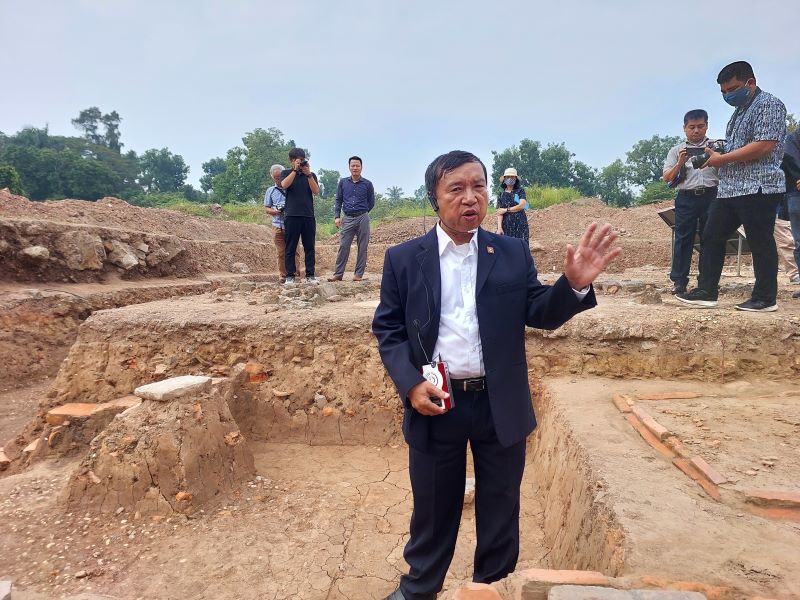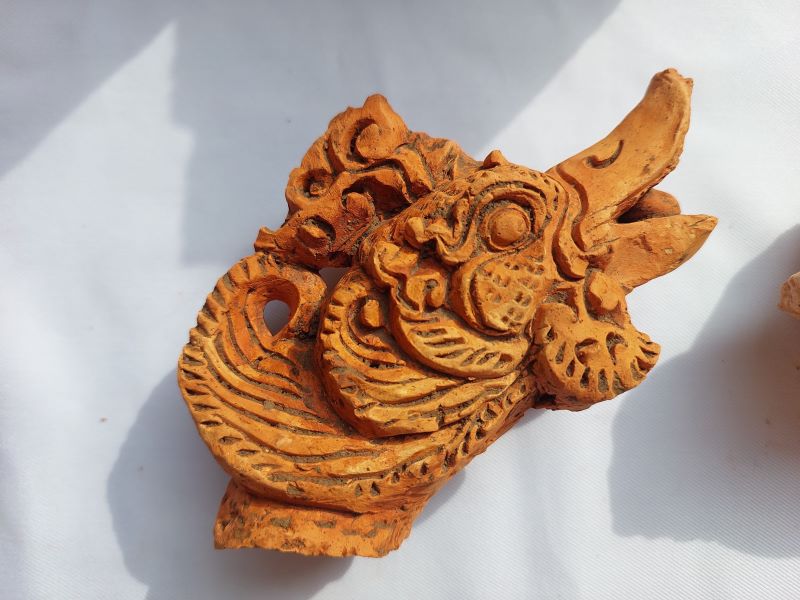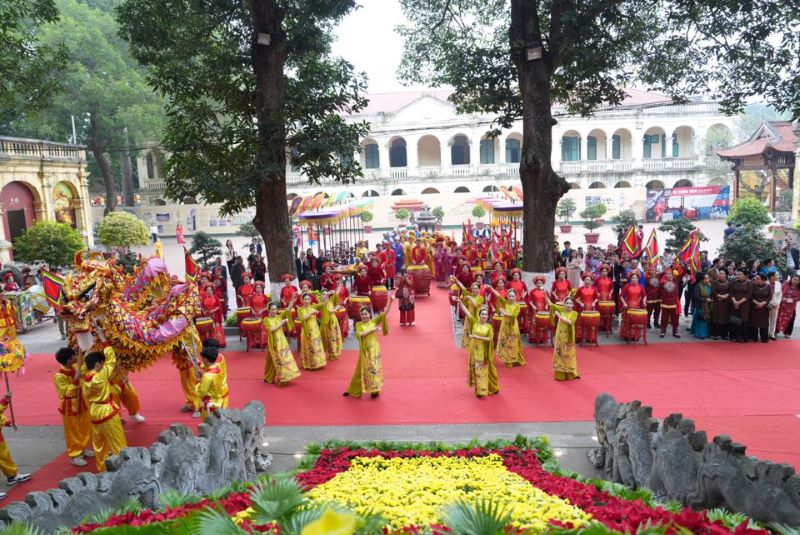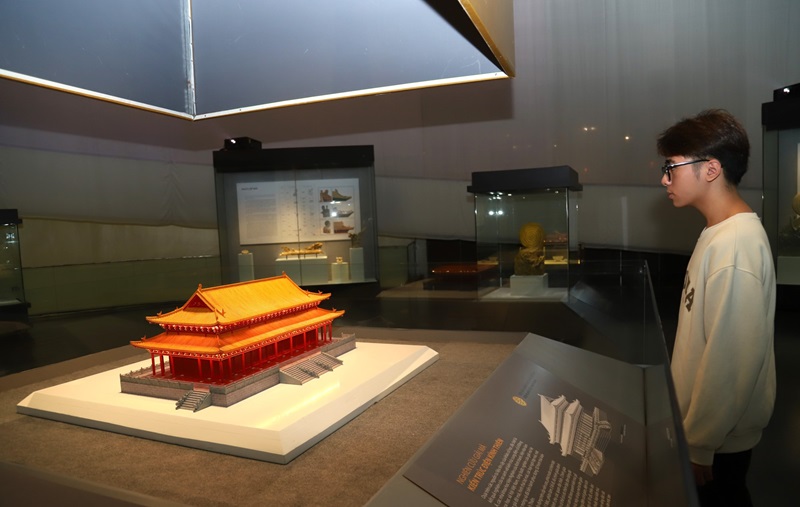
The restoration of Kinh Thien Palace, an important site where Vietnam's feudal courts once held solemn rituals, received foreign diplomats, and discussed state affairs, has involved a great deal of work by archaeologists and specialists for decades.
Mysteries unraveled
| The latest excavation results give a clearer picture of Kinh Thien Palace than before. Assoc. Prof. Dr. Tong Trung Tin, Chairman of the Vietnam Archaeological Association, explains the new findings. Photo: Tra My |
At its 46th session in late July, the UNESCO World Heritage Committee accepted Vietnam's proposals on the direction and vision of research, conservation, and development of the World Heritage Site of the Central Sector of the Thang Long Imperial Citadel.
The Committee highly appreciated Vietnam's achievements in fulfilling all the commitments made by the Government since the inscription of the site in 2010. With the approval of the dossier on the conservation and enhancement of the value of the Central Sector, the Zodiac Axis can be opened up, allowing for the restoration of the Kinh Thien Palace.
The restoration of the palace aims to decipher the secrets of its architecture and thus clarify the scientific value of the archaeological discoveries.
| A newly found artifact was collected from the excavations in 2022. |
Since 2011, the Thang Long - Hanoi Heritage Conservation Center has been working with the Institute of Archaeology under the Vietnam Academy of Social Sciences and the Vietnam Archaeological Association to excavate and conduct archaeological research in the area of Kinh Thien Palace, which covers about 10,000 square meters. The excavations have yielded successful results, collecting many new pieces of evidence of high authenticity, and facilitating the restoration of the palace.
According to the center, an excavation in 2023 at the foundation of Kinh Thien Palace uncovered layers with a total thickness of over three meters, showing continuous cultural layers from the Nguyen Dynasty to the Initial Le Dynasty. A portion of the remains of the Nguyen Dynasty's Long Thien Palace and the Le Dynasty's Kinh Thien Palace have been identified. This shows how well-preserved the underground remains are. Artifacts related to the development of architecture and life at the royal court, such as bricks, tiles, and ceramics, have also been unearthed.
| The night tour of the Thang Long Imperial Citadel offers visitors a deeper understanding of Vietnam's history. |
Dr. Tong Trung Tin, Chairman of the Vietnam Archaeological Association, said that scientists were more than halfway to understanding the restoration of Kinh Thien Palace.
"Remains of the Dai Trieu, or Dan Tri, courtyard, which is believed to have covered a total of 12,000 square meters, have also been discovered by archaeologists. Traces of the Imperial Path also remain. Although its surface is mostly damaged, the remaining materials show that it may have been paved with stone during the Revival Le Dynasty and with large square bricks during the Initial Le Dynasty,” he said.
In the results of the 2023 Kinh Thien Palace area excavation, Dr. Nguyen Viet Chuc, former Vice Chairman of the National Assembly Committee on Culture and Education, said that the results of the excavations in the area of the 2023 Kinh Thien Palace were interrelated and contributed to the discovery of many different tangible values. This is the basis for the reports to UNESCO on the state of preservation of the Thang Long Imperial Citadel.
Breathing "soul" into the legacy
| A traditional Vietnamese ritual is held in the courtyard of the former Kinh Thien Palace. Photo: Minh An |
According to Dang Van Bai, Vice Chairman of the National Council for Cultural Heritage, the project to conserve the heritage of the Thang Long Imperial Citadel and restore Kinh Thien Palace was highly commended because it followed UNESCO's direction on cultural heritage conservation as clearly stated in the guidelines for the implementation of the 1972 Convention.
The Kinh Thien Palace restoration project must answer the question of why it is necessary to dismantle the headquarters of the Department of Operations under the General Staff of the Vietnam People's Army. "Instead of doing standard demolition, we will conduct a study and adhere to scientific data both prior to and throughout the deconstruction process in accordance with the established principles and regulations."
However, restoration cannot be based on guesswork but requires careful research and scientific systematization of historical documents. The result must aim to clarify the palace's function and breathe life into the heritage site. "Excavation results and historical relics only allow us to imagine the external architecture. The interior and function of the building, as well as the nature of royal court life, traditional festivals, and so on, must be studied in detail. Research into these intangible heritages will help us carry out a meaningful restoration project," continued Dang Van Bai.
| Based on this research and comparing techniques and architectural styles, researchers have created a 3D model of the Kinh Thien Palace. |
He also suggested interpreting cultural heritage in combination with promotion using modern technology. The idea of a royal court museum displaying tangible and intangible relics was also mentioned.
The concept of identifying the space of Kinh Thien Palace is to find the central axis of Thang Long Citadel. Bui Minh Tri, Director of the Institute of Imperial Citadel Studies, noted that the restoration process has been anticipated by the people and scholars, but it cannot be done too hastily or based on mere suppositions.
"The more research and digging we do, the more difficult problems we encounter that require large investments. We are deciphering the Kinh Thien Palace with previous court palaces. Archaeology must be linked to history," he said.
After more than a decade of research, archaeologists have found reliable, authentic documents proving that Kinh Thien Palace has the architectural element called "dau cung" or "cap and block". Its roofs from the Initial Le Dynasty are an amazing work of "roof art". This is a crucial key to the research journey to unravel the mystery of the architectural form of the central palace.
| Researchers believe that Kinh Thien Palace features the architectural element called “dau cung” or “cap and block”. |
The restoration of the Kinh Thien Palace is scheduled to take place in 2026, which could have a significant impact on Hanoi's tourism and cultural industries.
After restoration, visitors to the Thang Long Imperial Citadel will have the opportunity to visualize the architectural complex - the center of power through various dynasties - and gain insight into Vietnamese history. To preserve the significance and vibrancy of the heritage, the interpretation of the architectural remains must be paired with new exhibits.
A historical treasure
Kinh Thien Palace is the court palace located in the center of the Forbidden Citadel of the Thang Long capital during the Initial Le Dynasty.
The ceremonial palace was built in 1428 during the reign of King Le Thai To (1428-1433) and completed during the reign of King Le Thanh Tong (1460-1497). It was the most important palace where the court held the most solemn rituals, received foreign envoys, and discussed the state's affairs.
After more than 388 years, in 1816, King Gia Long ordered the construction of a new and smaller building right on the foundation of the Kinh Thien Palace to serve as a resting place for the Nguyen kings when they traveled to the north.
| Thang Long Imperial Citadel by night. |
In 1886, after the French colonists occupied Hanoi, the Long Thien Palace (the new name since 1841) was destroyed to make way for a military building. The only remains of Kinh Thien Palace on the ground today are the stone sculptures of dragons that serve as stairway handrails.
According to archaeologists, the foundation and staircase of Kinh Thien Palace are meager relics of the palace architecture of the Le dynasty that have survived to this day, partly reflecting the grandeur of the Vietnamese feudal palace in the past.
Today, cultural events such as exhibitions and art shows are regularly held here, attracting a large number of visitors.
The palace was officially opened to the public in November 2004. Since then, it's become one of the most interesting places in the city.
With its outstanding historical, cultural, and scientific values, the Vietnamese government recognized the Imperial Citadel of Thang Long as a National Historical Site in 2009. The site was inscribed on the UNESCO World Heritage List in 2010.









.jpg)


.jpg)
.jpg)